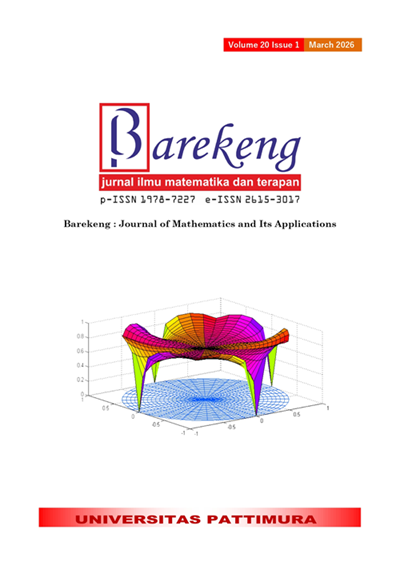NIL DERIVATIONS AND d-IDEALS ON POLYNOMIAL RINGS
Abstract
Let be a ring. An additive mapping is called derivation if satisfies Leibniz's rule, i.e., for every In a special case, for each there exists a positive integer which depends on such that , then is called as a nil derivation on . The concept of - ideal which is an ideal that remains stable under the derivation operation . This research presents a systematic construction of nil derivations on polynomial rings and investigates their corresponding nilpotency indices. Unlike prior studies that often treat derivations in abstract terms, this work emphasizes explicit constructions, offering concrete examples and techniques for generating such derivations. A key focus is the relationship between nil derivations and general nilpotent derivations, including an analysis of their linear combinations. Furthermore, the study provides new insights into the behavior of nil derivations in the context of d-ideals, shedding light on their structural properties within ring theory. To enhance understanding, each theoretical development is supported by illustrative examples, reinforcing the applicability and significance of the results.
Downloads
References
E. Guven, “ON (, )-DERIVATION IN PRIME RINGS,” Int. J. Contemp. Math. Sci., vol. 3, no. 26, pp. 1289–1293, 2008.
O. Golbasi and E. Koc, “GENERALIZED DERIVATIONS ON LIE IDEALS IN PRIME RINGS,” Turk. J. Math., vol. 35, pp. 23–28, 2011.doi: https://doi.org/10.3906/mat-0807-27
S. Ali, B. Dhara, and M. Khan, “ON PRIME AND SEMIPRIME RINGS WITH ADDITIVE MAPPINGS AND DERIVATIONS,” Univers. J. Comput. Math., vol. 11, no. 6, pp. 291–300, 2017.
S. Ali and H. Alhazmi, “ON GENERALIZED DERIVATIONS AND COMMUTATIVITY OF PRIME RINGS WITH INVOLUTION,” Int. J. Algebr., vol. 11, no. 6, pp. 291–300, 2017.doi: https://doi.org/10.12988/ija.2017.7839
M. Atteya, “COMMUTATIVITY WITH DERIVATIONS OF SEMIPRIME RINGS,” Discuss. Math. Gen. Algebr. Appl., vol. 40, pp. 165–175, 2020.doi: https://doi.org/10.7151/dmgaa.1333
S. Belkadi, S. Ali, and L. Taofiq, “ON NILPOTENT HOMODERIVATIONS IN PRIME RINGS,” Georg. Math. J., vol. 1, pp. 17–24, 2024.doi: https://doi.org/10.1515/gmj-2023-2065
S. Belkadi, S. Ali, and L. Taoufiq, “ON N-JORDAN HOMODERIVATIONS IN RINGS,” Georg. Math. J., vol. 1, pp. 17–24, 2024. doi: https://doi.org/10.1515/gmj-2023-2065
T. M. S. El-Sayiad, A. Ageeb, and A. Ghareeb, “CENTRALIZING N-HOMODERIVATIONS OF SEMIPRIME RINGS,” J. Math., p. 1112183, 2022. doi: https://doi.org/10.1155/2022/1112183
S. F. El-Deken and M. M. El-Soufi, “ON CENTRALLY-EXTENDED REVERSE AND GENERALIZED REVERSE DERIVATIONS,” Indian J. Pure Appl. Math., vol. 51, no. 3, pp. 1165–1180, 2020. doi: https://doi.org/10.1007/s13226-020-0456-y
M. M. El-Soufi and A. Ghareeb, “CENTRALLY EXTENDED-HOMODERIVATIONS ON PRIME AND SEMIPRIME RINGS,” J. Math., p. 2584177, 2022.doi: https://doi.org/10.1155/2022/2584177
A. B. Thomas, N. P. Puspita, and Fitriani, “DERIVATION ON SEVERAL RINGS,” BAREKENG J. Ilmu Mat. dan Terap., vol. 18, no. 3, pp. 1729–1738, Jul. 2024, doi: https://doi.org/10.30598/barekengvol18iss3pp1729-1738.
O. H. Ezzat, “RINGS WITH CENTRALLY EXTENDED HIGHER *DERIVATION,” Adv. Appl. Clifford Algebr., vol. 23, no. 21, 2023.doi: https://doi.org/10.1007/s00006-023-01265-z
A. Gouda and H. Nabiel, “ON CENTRALLY-EXTENDED LEFT DERIVATIONS IN RINGS,” Arab. J. Math., vol. 13, pp. 513–519, 2024.doi: https://doi.org/10.1007/s40065-024-00481-0
J. Bracic, “REPRESENTATIONS AND DERIVATIONS OF MODULES,” Irish Math. Soc. Bull., vol. 47, pp. 27–39, 2001.doi: https://doi.org/10.33232/BIMS.0047.27.40
A. Patra and R. V. Gurjar, “ON MINIMUM NUMBER OF GENERATORS FOR SOME DERIVATION MODULES,” J. Pure Appl. Algebr., vol. 226, no. 11, p. 107105, 2022.doi: https://doi.org/10.1016/j.jpaa.2022.107105
K. Retert, “SETS OF COMMUTING DERIVATIONS AND SIMPLICITY,” Commun. Algebr., vol. 34, no. 8, pp. 2941–2963, 2006.doi: https://doi.org/10.1080/00927870600639492
Z. Chen and B. Wang, “COMMUTING DERIVATIONS AND AUTOMORPHISMS OF CERTAIN NILPOTENT LIE ALGEBRAS OVER COMMUTATIVE RINGS,” Commun. Algebr., vol. 43, no. 5, pp. 2044–2061, 2015.doi: https://doi.org/10.1080/00927872.2014.882932
S. Maubach, “THE COMMUTING DERIVATION CONJECTURE,” J. Pure Appl. Algebr., vol. 179, no. 1, pp. 159–168, 2003.doi: https://doi.org/10.1016/S0022-4049(02)00198-6
G. Pogudin, “A PRIMITIVE ELEMENT THEOREM FOR FIELDS WITH COMMUTING DERIVATIONS AND AUTOMORPHISMS,” Sel. Math., vol. 25, no. 4, pp. 1–19, 2019.doi: https://doi.org/10.1007/s00029-019-0504-9
Fitriani, I. E. Wijayanti, A. Faisol, and S. Ali, “COMMUTING AND CENTRALIZING MAPS ON MODULES,” vol. 10, no. 3, pp. 691–697, 2025.doi: https://doi.org/10.26554/sti.2025.10.3.690-697
Fitriani, I. E. Wijayanti, A. Faisol, and S. Ali, “ON F-DERIVATIONS ON POLYNOMIAL MODULES,” J. Algebr. its Appl., vol. 24, no. 6, pp. 1–14, 2024, doi: https://doi.org/10.1142/S0219498825501555.
M. K. Malik, D.S., Moderson, J.M., and Sen, FUNDAMENTAL OF ABSTRACT ALGEBRA. New York: McGraw-Hill Company, 1998.
L. O. Chung, “NIL DERIVATIONS,” J. Algebr., vol. 95, pp. 20–30, 1985.doi: https://doi.org/10.1016/0021-8693(85)90089-4
M. R. Helmi, H. Marubayashi, and A. Ueda, “DIFFERENTIAL POLYNOMIAL RINGS WHICH ARE GENERALIZED ASANO PRIME RING,” Indian J. Pure Appl. Math., vol. 44(5), pp. 673–681, 2013.doi: https://doi.org/10.1007/s13226-013-0035-6
S. Ali, N. N. Rafiquee, and V. Varshney, “CERTAIN TYPES OF DERIVATIONS IN RINGS: A SURVEY,” J. Indones. Math. Soc, vol. 30, no. 02, pp. 256–306, 2024.doi: https://doi.org/10.22342/jims.30.2.1623.256-306
I. Ernanto, “SIFAT-SIFAT RING FAKTOR YANG DILENGKAPI DERIVASI,” J. Fundam. Math. Appl., vol. 1, no. 1, p. 12, Jun. 2018, doi: https://doi.org/10.14710/jfma.v1i1.3.
Fitriani and A. Faisol, GRUP. Yogyakarta: Matematika, 2022.
O. Luisa, Yanita, and N. N. Bakar, “TEOREMA PEMBAGIAN PADA RING POLINOMIAL R[X],” J. Mat. UNAND, vol. VIII, no. 1, pp. 249–254, 2019.doi: https://doi.org/10.25077/jmu.8.1.249-254.2019
S. Wahyuni, I. E. Wijayanti, D. A. Yuwaningsih, and A. D. Hartanto, TEORI RING DAN MODUL. Yogyakarta: Gadjah Mada University Press, 2021.
M. Sahai and S. F. Ansari, “Derivations and centralizers in rings,” Palest. J. Math., vol. 11, no. (2), pp. 413–419, 2022.
Copyright (c) 2025 Ditha Lathifatul Mursyidah, Fitriani Fitriani, Bernadhita Herindri Samodera Utami, Ahmad Faisol

This work is licensed under a Creative Commons Attribution-ShareAlike 4.0 International License.
Authors who publish with this Journal agree to the following terms:
- Author retain copyright and grant the journal right of first publication with the work simultaneously licensed under a creative commons attribution license that allow others to share the work within an acknowledgement of the work’s authorship and initial publication of this journal.
- Authors are able to enter into separate, additional contractual arrangement for the non-exclusive distribution of the journal’s published version of the work (e.g. acknowledgement of its initial publication in this journal).
- Authors are permitted and encouraged to post their work online (e.g. in institutional repositories or on their websites) prior to and during the submission process, as it can lead to productive exchanges, as well as earlier and greater citation of published works.






1.gif)



